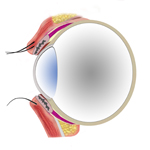This topic is addressing perhaps the most difficult procedure to do. First of all, anything done around the eyes has the smallest margin of error. You can have a tiny variance of less than a millimeter and have it become very noticeable when anything is around the eyes. That is why, procedures around the eyes have to be done with the utmost accuracy.
This is why Asian Eyelid surgery is so difficult. Some reasons for revision are ptosis. This is a condition where the eyelid margin is lower than it previously was before. When you do eyelid surgery for Asians and the goal is to recreate the eyelid crease, you have to work on the muscle that pulls up the eyelid. It is essential to attach the skin edges, or elements of, to this muscle called the levator aponeurosis. Sometimes work on this muscle can damage this muscle and lead to different affects on its function. This can result in differences in movement and thus ultimately the height of the eyelid margin. Very small degrees of ptosis, or eyelid margin being lower than normal, can be noticeable to people The way to treat ptosis is to expose the aponeurosis and shorten it through sutures. This is done by grabbing the levator and attaching it to the tarsus which is the cartilage near the eyelid margin.
Other reasons for revisions include asymmetrical eyelid creases / folds, too much fat taken out of the eyelids, discontinuous creases, multiple folds, round eye deformity, etc.
For asymmetrical creases, if it is a lower eyelid crease that is desired, one needs to find what the height is desired and then the new crease is incised and the old crease needs to be released. To prevent adhesion, you can place a fascia graft (tissue from muscle covering), or fat graft from another source into the area that is released and also to prevent readhesion. Another way of doing that, is to lower the fat inside the eyelid over the area of adhesion. But in the case that the eyelid fat is lacking, you need to use fascia grafts or fat from another source as noted above. The best option is to use the free fat grafts. Of all of the tissues that helps to prevent adhesion, fat is the best tissue to use.
For multiple creases, this situation is essentially like a crease that you want to remove. This requires elevation of the crease and prevention of readhesion with the techniques that were just mentioned with tissue grafts as above.
For discontinuous creases, you have to recreate the crease which may entail a new incision and redoing the crease forming sutures that were done before. Some variations of this can be done to cause longer lasting fixation. Some recreation of the creases can be done with longer lasting sutures that are placed below the skin level and allowed to absorb on their own. Other techniques can be done to improve the fixation.
Taking too much fat entails adding fat grafts. This can be done with free fat grafts through an incision technique or through harvesting with a cannula. Here is video on Asian Blepharoplasty and Medial epicanthoplasty.
Thanks for reading, Dr Young
Dr Young specializes in Facial Cosmetic and Reconstructive Surgery and is located in Bellevue near Seattle, Washington
